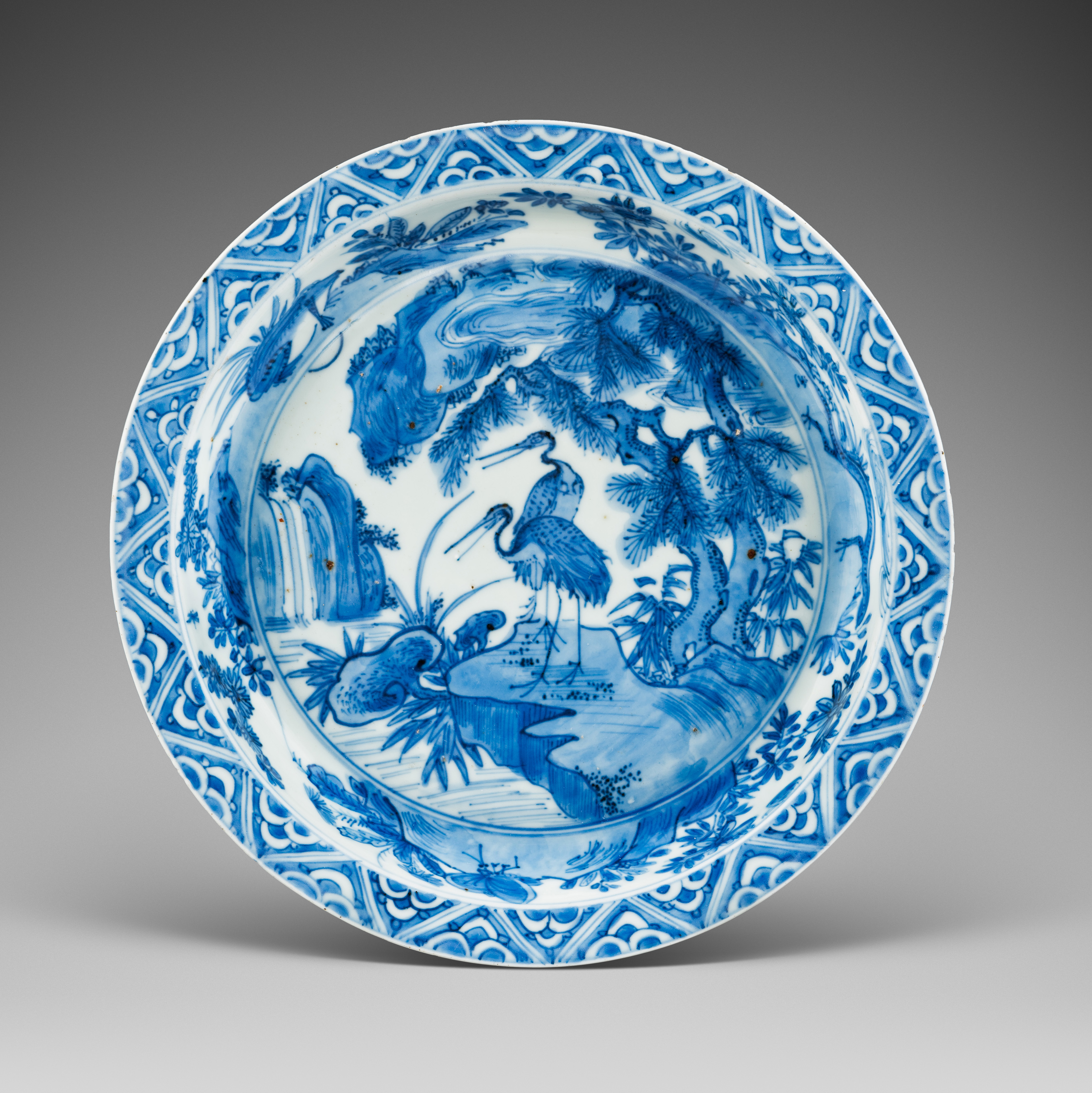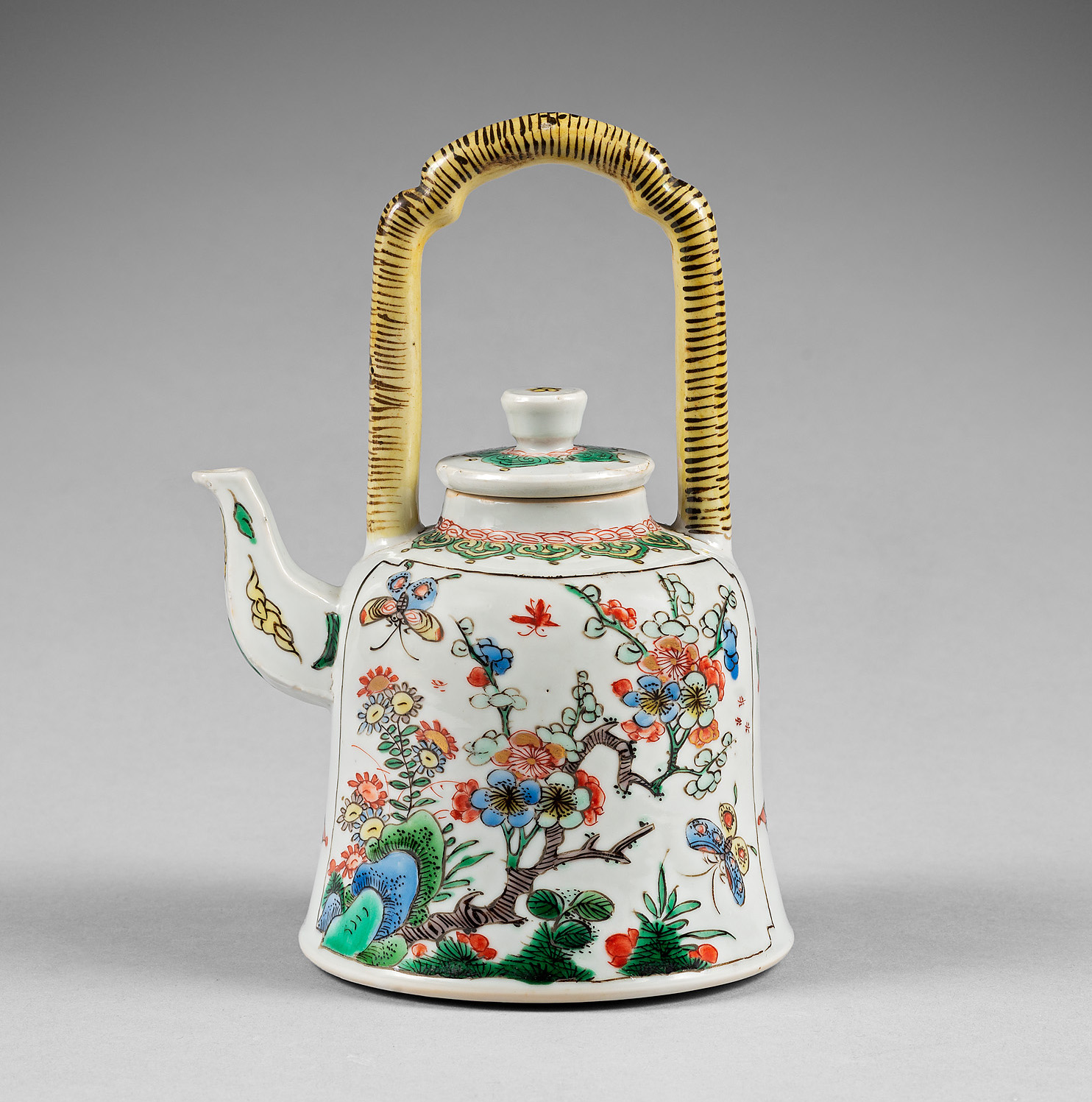

Underglaze cobalt blue porcelain dish bearing the egret mark. Ming dynasty, Wanli
Thinly potted, this small dish has deep rounded sides, a narrow flat, upturned rim, and a low foot ring that slants slightly inwards. It is finely decorated in deep shades of underglaze cobalt blue. The centre shows two cranes standing on a rock beneath a pine tree and clouds, looking at a waterfall. The cavetto is painted with a continuous naturalistic scene showing a large frog, a lizard, and a butterfly on rocks amongst flowering plants, and the rim with a white-on-blue zig-zag and overlapping petal border. The reverse is painted with two opposing thorny prunus branches, each with a bird perched on one branch. The recessed base bears the egret mark at the centre.
Photography : Jérémie Beylard / Agence PHAR
- Country:
- China
- Period :
- China, Ming dynasty, Wanli reign (1573-1620)
- Material:
- Porcelain
- Dimension:
- 20.5 cm; height: 3 cm
- Reference :
- D863
- Status:
- sold
Provenance
From a French private collection
Notice
By Dr. Teresa Canepa
This porcelain dish is noteworthy for its extremely fine potting and painted decoration. It belongs to a small group of pieces that bear the egret mark on their bases.[1] The majority are kraak plates, saucer-dishes, and klapmutsen, usually of exceptionally high quality, produced with a well-levigated clay and crisply moulded decoration, and finely decorated in deep shades of underglaze cobalt blue.[2] There are three distinct variants of the egret mark.[3]
Egret mark dishes of this particular shape and high-quality painted decoration are exceedingly rare. The present dish and another example of this size sold at auction in May 2000,[4] appear to be the only egret mark dishes of this type recorded thus far.[5] The latter example, painted at the centre with a warrior riding a galloping horse across a rocky landscape, shows the same rim border and a continuous scene on the cavetto with a lizard on a rock amongst bamboo and other plants. The egret mark has also been recorded on a few saucer-dishes, ranging from about 17 to 22 cm in diameter, painted on the cavetto with related scenes showing flowering plants, insects, and butterflies.[6] This dish, as well as the aforementioned comparable dish and saucer-dishes, bear the first variant of the egret mark, in which the egret has a slender, erect body with serrated feathers, a straight neck, a thin beak and long legs that terminate in two circles, most probably representing its feet.
The fact that no porcelain pieces bearing the egret mark have been excavated at Jingdezhen until now makes it impossible to ascertain if all the pieces from this group were fired in only one kiln or in different kilns. Judging by its high quality, it seems possible that a egret mark dish such as this example could have been fired at the Guanyinge kiln, a private kiln located in the Old City Zone of Jingdezhen, where a fragment of a high-quality kraak dish or saucer-dish with a related central scene of cranes standing on a rock beneath a pine tree was excavated.[7] This also applies to two kraak plates finely painted with similar crane scenes that bear the egret mark found in the Gemeentemuseum in the Hague and the Princessehof Museum in Leeuwarden.[8]
Thus far a fragment that appears to have formed part of a kraak klapmuts is the only archaeological find of porcelain bearing the egret mark. Excavated in Macao, the Portuguese trading post established in 1557, it proves that the Portuguese acquired porcelain with the egret mark.[9] Other tangible evidence is provided by an egret mark kraak saucer-dish that is among the porcelain incorporated as architectural features in the pyramidal ceiling of a small drawing room in the Santos Palace, the present-day French Embassy, in Lisbon.[10] Both the excavated klapmuts fragment and the Santos Palace saucer-dish bear the first variant of the egret mark.
Dr. Teresa Canepa is an independent researcher and lecturer in Chinese and Japanese art, and currently a council member of the Oriental Ceramic Society in London and co-editor of the OCS newsletter. She completed a Ph.D. in Art History at Leiden University, The Netherlands, and is the author of Silk, Porcelain and Lacquer: China and Japan and their trade with Western Europe and the New World, 1500-1644 (Paul Holberton Publishing, London, 2016); and Jingdezhen to the World: The Lurie Collection of Chinese Export Porcelain from the Late Ming Dynasty (Ad Ilissvm, London, 2019); and co-author with Katharine Butler of Leaping the Dragon Gate: The Sir Michael Butler Collection of Seventeenth-Century Chinese Porcelain (Ad Ilissvm, London, 2021). She has published a number of articles and lectured widely on these subjects.
[1] Maura Rinaldi discussed forty-five pieces with the egret mark in 1989, and Eva Ströber noted in 2013 that there are about sixty of them recorded, twenty of which are in the Netherlands. A few other egret mark pieces have appeared in the international art market since then. See Maura Rinaldi, Kraak Porcelain. A Moment in the History of Trade, London, 1989, pp. 195–208; and Eva Ströber, Ming Porcelain for a Globalised Trade, Stuttgart, 2013, p. 208.
[2] For a recent discussion on pieces with the egret mark, see Teresa Canepa, Jingdezhen to the World. The Lurie Collection of Chinese Export Porcelain of the Late Ming Dynasty, London, 2019, pp. 28, 76–91, nos. 15–20. A few rare egret mark saucer-dishes of small size combining underglaze cobalt blue and monochrome blue glaze decoration, two of them in the Sir Michael Butler Collection, are discussed in Teresa Canepa and Katharine Butler, Leaping the Dragon Gate. The Sir Michael Butler Collection of 17th-Century Chinese Porcelain, London, 2021, pp. 74–5, nos. III.1.20 and III.1.21.
[3] The three variants are discussed in Jean de Faramond, ‘The egret mark on blue and white Wan Li export porcelain (‘Kraak’ porcelain)’, Mededelingenblad Vrienden van de Nederlandse Ceramiek, vol. 89, no. 1, 1978, pp. 24–7; Rinaldi, 1989, pp. 195–96; and Canepa, 2019, p. 78.
[4] Offered as lot 18 in Asian Ceramics and Works of Arts, Christie’s Amsterdam, 10 May 2000, sale 2455.
[5] No dishes of this type were included among the forty-five pieces bearing the egret mark published by Maura Rinaldi in 1989.
[6] Two saucer-dishes, one in the Groninger Museum in Groningen and the other in the Topkapi Saray Museum in Istanbul, are published in Rinaldi, 1989, p. 206, pl. 266a and b. Another example was offered for sale as lot 623 at Rob Michiels Auctions in Bruges in May 2020.
[7] Published in Canepa, 2019, p. 94, figs. I.21a and b. High-quality kraak plates with related crane scenes with a white cavetto and a continuous naturalistic border which do not bear the egret mark, like an example in the Lurie Collection, may have also been fired at this kiln. See Ibid., pp. 92–5, no. 21.
[8] Christiaan Jörg, Oriental Porcelain in the Netherlands. Four museum collections, exhibition catalogue, Groninger Museum, Groningen, 2003, p. 22, no. 5.
[9] The front and reverse of the fragment are published in Canepa, 2019, p. 80, figs. I.15a and b.
[10] Published in Claire Déléry and Huei-Chung Tsao, eds, Chinese Porcelains of the Santos Palace, Paris, 2021, pp. 332–33.

























